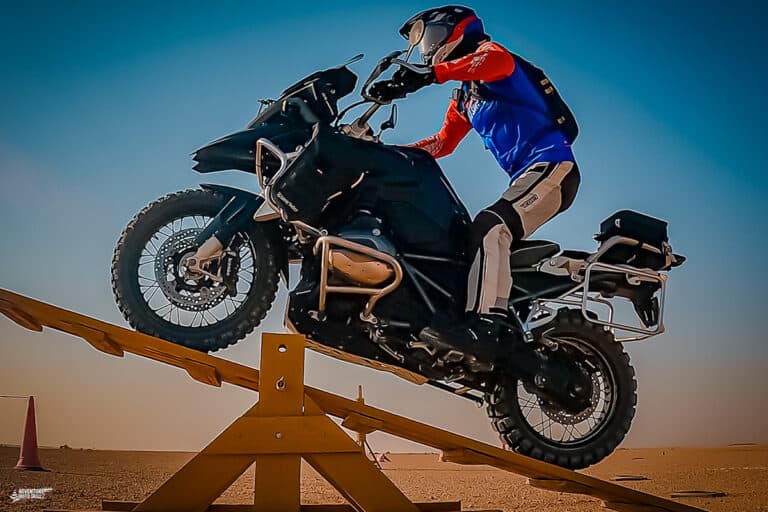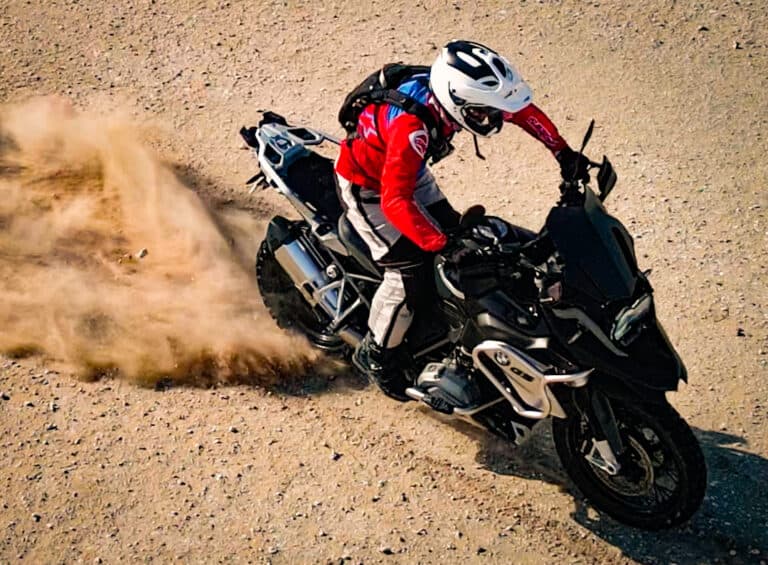Standing and Seated ADV Motorcycle Riding: And When to Walk it
Standing and seated ADV motorcycle riding positions each have their rightful place in ADV motorcycling. Riders often ask, “Which riding position is best off-road?”. The better question is, “When should each riding position be used?”.
ADV motorcyclists use a standing riding position to improve bike control on arduous off-road terrain. Off-road seated posture is often employed on less technical sections and for recovery. Riders should walk the bike out of dangerous areas or those beyond their current skill level.
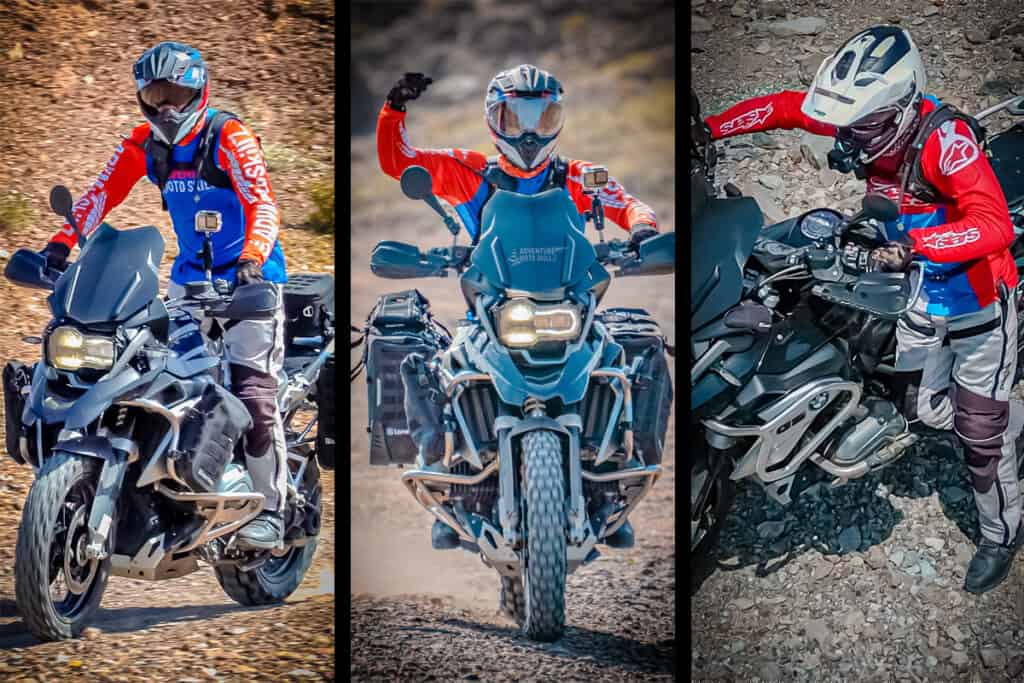
I love riding my BMW R1200GS while standing. The versatility and advantages of riding tall are many. But I do not spend 100% of my time there. Seated riding and the occasional walking of the bike play an important role in every ride. So let’s take a look at each option.
This post may contain Affiliate Links. Please see our Privacy & Disclosure Policy for more details.

Top-quality gear for your next adventure
Used and recommended by ADVMotoSkillZ
Standing riding position for off-road ADV motorcycling
Better bike control and improved line of sight are two major benefits of a standing riding position. I spend about 80% of my off-road ride time standing. It is a comfortable and confident position, not to mention the ability to get more airflow to cool off.
Let’s discuss the vision advantage first. ADV motorcycles are already tall bikes with high-ground clearance. But by standing on the pegs, you can create a totally new visual riding experience. To view your surroundings from standing versus seated means you broaden your visual field.
Perform this test if you are comfortable riding from a standing position:
- Drive down the road in a seated riding position.
- Notice how far you can see into the distance.
- When it is safe, turn your head left and right to assess your surroundings.
- Now transition into standing riding position.
- Notice how much further you can see into the distance.
- When it is safe, turn left and right to assess your surroundings … realize how much more rotation is available to you when standing.
- Notice how much more information you can collect about your surroundings from a standing position.
If you are not comfortable riding in a standing position yet, perform this same test with your bike on its center stand.

Elevate your off-road adventure with the standing riding position, optimizing your line of sight. By looking a step or two ahead on the trail, you can adapt to obstacles and terrain variations. This stance empowers you to fine-tune your body position and throttle control effectively before you get there.
Now let’s talk about off-road bike control. If rocks, bumps, obstacles, or loose shifting terrain are planned into your ride, then it’s time to dial in your bike control skills. Body position learning is one of the keys to improving bike control. Check out our more detailed posts on foot position (here), knees and hip position (here), and upper body position (here).
When you ride in the standing position, you unlock a whole new level of control and agility. The upright stance allows you to distribute your weight more effectively, enhancing your ability to maneuver through tight corners or navigate challenging terrains.
As an off-road rider, you’ll encounter various terrains, each requiring adjustments to your standing position. On well-packed gravel roads or smoother surfaces, you can maintain a relaxed and neutral standing posture. To enhance the bike’s stability and tackle tougher terrains, bend your knees slightly more, shift your hips rearward and side to side, and raise your elbows wide.
Check out this video showing this concept in action:
Seated riding position for off-road ADV motorcycling
Riding seated when off-road is an option on many surfaces like packed dirt, gravel roads, or hard-pack sand dunes. It can also be an intelligent choice when navigating a rough section of trail that might be a little above your current skill level. The most significant benefits of being seated are allowing you to get a foot down quickly and to rest and recover from more demanding sections.
Perhaps you have just finished a long stretch of gnarly rutted single track. Finally, you reach a length of hard-packed gravel. This is a great time to take a seat, have a sip of water from your hydration backpack, and rest your legs. When the next bumpy sections come, you can stand again then.
Take note that off-road seated body position will be different than when on-road. When on tarmac, we can have a stable high traction surface to ride on. The steady grip of the tires on the road allows for more predictable traction so we can sit back and enjoy the view.
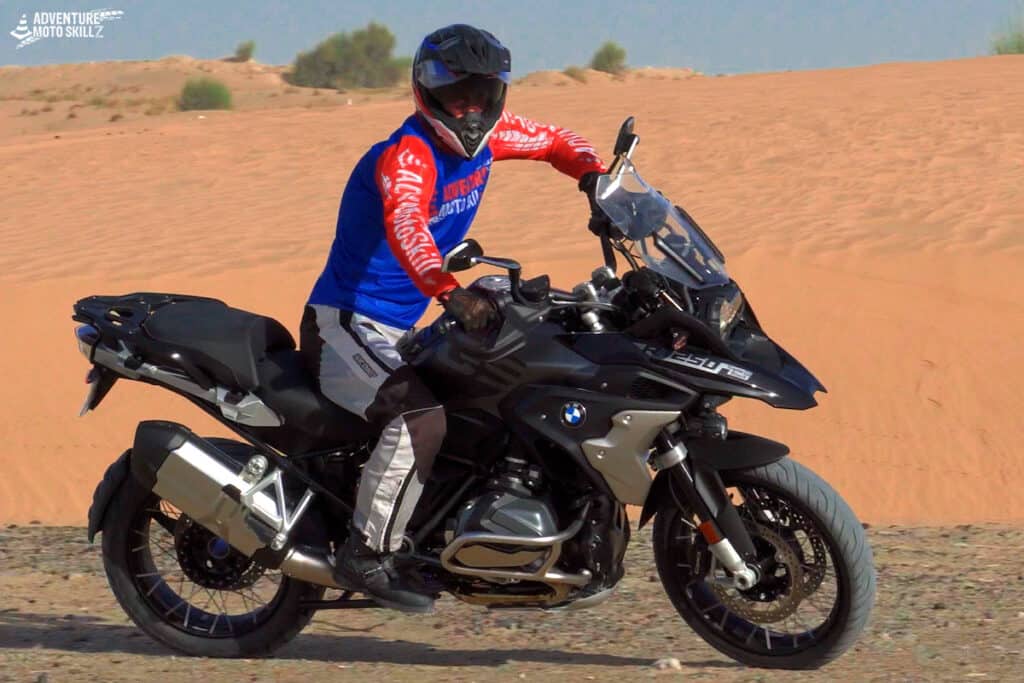
Off-road traction is a mix of low to medium grip potential. If you adopt a relaxed on-road seated posture on these surfaces, the front tire will likely get away from you. Instead, slide your butt forward to the front part of the seat.
By sitting more forward, you can get your chest centered over the tank if needed, and it naturally puts more weight on the front end. This extra weight translates into more traction for the front tire.
Remember to keep a comfortable grip on the handlebars and keep your elbows out wide. Relaxed shoulders and wide elbows will make you more responsive to the terrain and provide for a more comfortable ride.
The same concept holds true for off-road seated cornering. If you and the bike lean into a corner off-road (like when you are on-road), the lack of traction will likely cause a drop. Instead, allow the bike to lean into the corner while you slide your buttocks to the opposite side of the seat. Stack your outside shoulder over your outer hip and lift that elbow wide. This creates a seated counterbalance effect that will help keep you upright.
If you prefer to ride off-road in the seated position, choose your ride location appropriately. Loose or shifting terrain (think soft sand or loose gravel) is not the time to stay seated. The bike will lack control and maximum maneuverability, which could down the bike.
Dirt roads and hard-packed gravel are the best surfaces to pick if you like seated off-road riding.

Innovative Motorcycle Tool Sets – Compact & Reliable
Used and recommended by ADVMotoSkillZ
When paddling or walking your motorcycle is the best choice
There are two ways to walk a bike out of a tricky situation. It is worth practicing them to feel more confident when you go off-road.
First is the seated paddle or duck walk. To do this:
- Remain seated on the bike and place both feet on the ground
- Pull in the clutch lever fully and shift to 1st or 2nd gear (terrain dependent)
- Begin to feather the clutch to deliver power to the rear wheel as you walk forward from atop the bike
- Keep taking one step forward (left-right-left-right) until you are out of the section.
The benefit of the duck walk technique is that you get to remain on the bike. Once you are through the tricky section, you can immediately throttle out to continue your ride.
However, this move may not be an option if you can not get both feet on the ground. Also, this method is a bit slower going than our next method.
The second walking method is standing on the bike’s side. To do this:
- Stand on either side of the bike, and hold both handlebars (standing on the left will feel more comfortable if possible).
- Allow the bike to lean towards your left hip so that you can support some of the bike’s weight with your legs (not just your arms)
- Pull in the clutch lever fully and shift to 1st or 2nd gear (terrain dependent)
- Begin to feather the clutch to deliver power to the rear wheel as you walk forward.
- Keep taking one step forward (left-right-left-right) until you are out of the section.

The benefit of the standing walk-out method is that both feet are planted firmly on the ground. Therefore, walking in this upright position is more natural than seated paddling. This walking approach is possible regardless of height or strength.
This technique may feel awkward if you have never done it before. It is an incredibly odd feeling from the right side of the bike. Practice on firm, stable terrain before trying it out on the trails.
When is walking the bike the smartest option?
- Mechanical failure of the bike
- Technical terrain that exceeds your current skill level
- Following a tip over in a seriously rutted or rocky patch
- In case of rider illness or injury
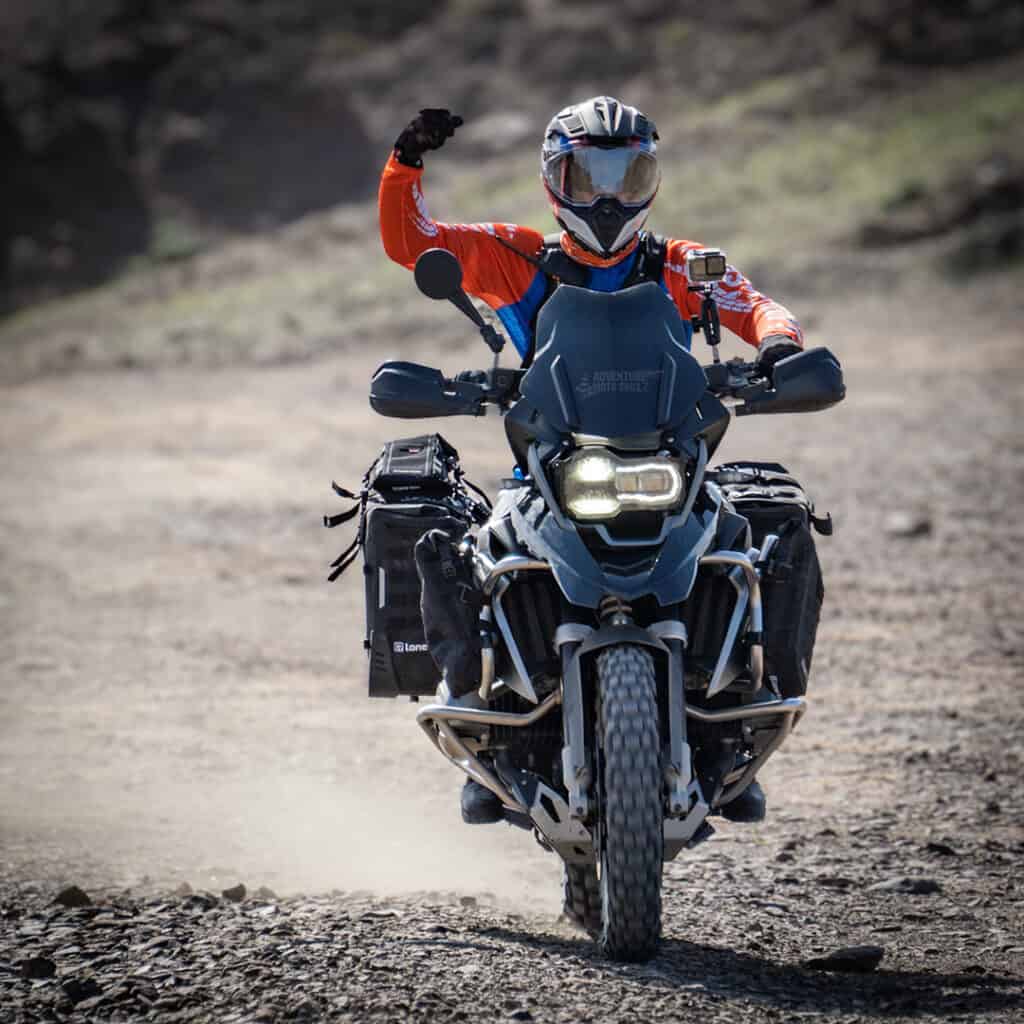
About the Author
Coach Mike is a Certified Off-Road Motorcycle Instructor & founder of ADVMotoSkillZ.
Riding tips from ADVMotoSkillZ reach thousands of international riders daily through social & blogs.
Click here to learn more about Mike’s motorcycle evolution from a Harley road rider to finding his true passion for off-road riding on a BMW 1200 GS.
If you would like to send Mike a quick message or invite him to provide training at your local facility, then visit the contact page here.

